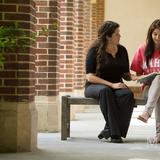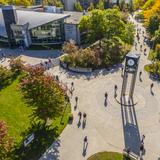- Inside all of us is the potential to rise higher. For more than 155 years, Bryant & Stratton College has helped students and working adults move up to a brighter future with a quality college education. As a private, personalized college, we can focus on the success of the individual student and provide a supportive, friendly environment for higher learning. If you’re looking for a supportive environment to follow your dreams of a college degree, you’ll find it here. We are 100% committed to helping you earn your college degree from financial aid to personalized tutoring—and succeed in life through career advisement and additional career education. From the moment you first speak to a Bryant & Stratton College representative, you’ll sense that we’re a different kind of college.
School Highlights
Bryant & Stratton College-Albany serves 394 students (73% of students are full-time).
The college's student:teacher ratio of 4:1 is lower than the state community college average of 13:1.
Minority enrollment is 74% of the student body (majority Black), which is more than the state average of 62%.
Quick Stats (2025)
- Enrollment: 394 students
- Private-state tuition: $16,424
- Acceptance Rate: 61%
- Student:teacher ratio: 4:1
- Minority enrollment: 74%
- Source: Verified school update
Top Rankings
Bryant & Stratton College-Albany ranks among the top 20% of public schools in New York for:
Category
Attribute
Diversity
School Overview
The teacher population of 90 teachers has stayed relatively flat over five years.
Bryant & Stratton College-Albany
(NY) Community College Avg.
Carnegie Classification
Baccalaureate/Associate's Colleges: Associate's Dominant
Baccalaureate/Associate's Colleges: Mixed Baccalaureate/Associate's
Institution Level
Four or more years
At least 2 but less than 4 years
Institution Control
Private not-for-profit
Private not-for-profit
Total Faculty
90 staff
158 staff

School Calendar
Student Body
The student population of Bryant & Stratton College-Albany has declined by 5% over five years.
The student:teacher ratio of 4:1 has stayed the same over five years.
The Bryant & Stratton College-Albany diversity score of 0.76 is equal to the state average of 0.76. The school's diversity has grown by 6% over five years.
Total Enrollment
394 students
746 students

Student : Teacher Ratio
4:1
13:1

# Full-Time Students
287 students
519 students

# Part-Time Students
107 students
514 students



# Enrollment Undergraduate
394 students
357 students
# Full-Time Undergraduate Students
287 students
502 students

# Full-Time Graduate Students
n/a
44 students
# Part-Time Undergraduate Students
107 students
528 students
# Part-Time Graduate Students
n/a
41 students
Total Dormitory Capacity
n/a
382 students
% American Indian/Alaskan
1%
n/a

% Asian
4%
8%

% Hispanic
22%
23%

% Black
34%
18%

% White
26%
38%

% Hawaiian
n/a
2%

% Two or more races
10%
3%

% Non Resident races
n/a
3%

% Unknown races
3%
5%


Diversity Score
0.76
0.76

College Completion Rate (Students who graduate in less than 4 years)
42%
26%

College Completion Rate (Students who graduate in 4 years or more than 4 years)
0.3333%
0.3957%
Average Graduate Earnings (10 Years)
$24,300
$35,200

Tuition and Acceptance Rate
The private state tuition of $16,424 is less than the state average of $16,426. The private state tuition has declined by 9% over four years.
Private State Tuition Fees
$16,424
$16,426

% Students Receiving Some Financial Aid
91%
88%

Median Debt for Graduates
$20,884
$13,841

Median Debt for Dropouts
$6,533
$5,500

Acceptance Rate
61%
61%

SAT Reading
n/a
475
SAT Math
n/a
505
SAT Writing
n/a
485
ACT Composite
n/a
20
ACT English
n/a
18
ACT Math
n/a
20
Source: 2024 (or latest year available) Integrated Postsecondary Education Data System (IPEDS)
School Notes
- Bryant & Stratton College's 15 degree programs provide you with cutting edge skills as well as real-world experience, giving you a decided advantage in fields with exciting futures. Through accelerated degree programs and flexible schedules, including day, evening, weekend or online courses, Bryant & Stratton College can get you into the workforce faster. Our Bachelor Degree programs can help take your career to the next level. Plus, you can enhance your professional development and opportunities through our Professional Skills Center (PSC) that offers courses in leadership, teamwork, sales performance and more. Bryant & Stratton College degree programs provide you with those cutting edge skills as well as real-world experience, giving you a decided advantage in fields with exciting futures. Degrees offered at the Albany Campus includes Accounting, Administrative Assistant, Business, Criminal Justice, Human Resources Specialist, Information Technology, Medical Administrative Assistant, Medical Assisting and Paralegal Studies.
Frequently Asked Questions
How much does Bryant & Stratton College-Albany cost?
Bryant & Stratton College-Albany's private state tuition is approximately $16,424.
What is the acceptance rate of Bryant & Stratton College-Albany?
The acceptance rate of Bryant & Stratton College-Albany is 61%, which is equal to the state average of 61%.
What is Bryant & Stratton College-Albany's ranking?
Bryant & Stratton College-Albany ranks among the top 20% of community college in New York for: Diversity in US community colleges.
Recent Articles

Obtaining Your Bachelor's Degree at a Community College
Explore the evolving landscape of community colleges offering bachelor's degrees, addressing affordability, accessibility, and workforce needs.

A to Z of Community College Certificates and Courses
From business and healthcare to technology and skilled trades, the article showcases the breadth of options available to students seeking to enhance their knowledge, develop new skills, or pursue career advancement.

What is a Community College?
This comprehensive guide explains what a community college is, its history, and its role in higher education. It covers the types of programs offered, differences from four-year colleges, benefits of attending, and important considerations for prospective students, providing valuable insights for those exploring educational options.







